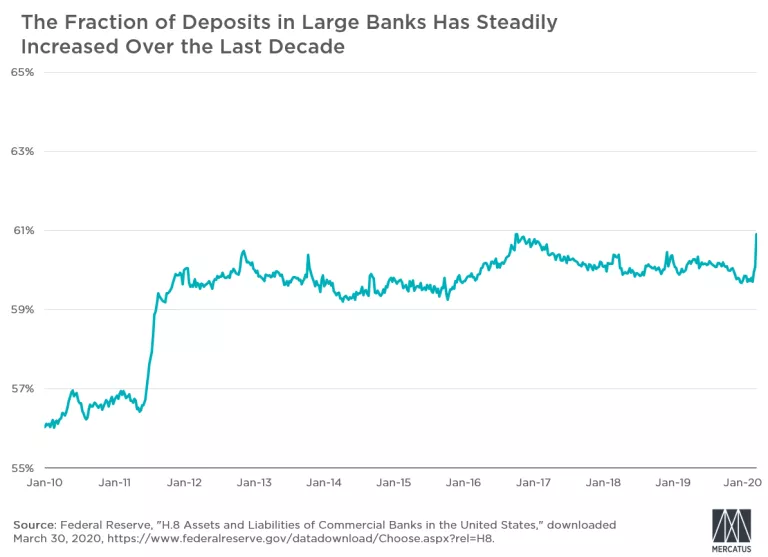- | Financial Markets Financial Markets
- | Expert Commentary Expert Commentary
- |
The COVID-19 Crisis Will Accelerate Bank Consolidation
Uncertain times prompt people to flock to safe havens like large banks
Crises, panic, and the flight to safe havens are the invariable ingredients that accelerate consolidation within the financial industry. This appears again to be the case with the COVID-19 pandemic and its follow-on economic and financial crisis.
A recent Bloomberg article recently highlighted the extraordinary growth of deposits at the 25 largest US banks where, from year-end 2019 to mid-March, accounts at these largest banks increased by $500 billion. Commentators have described this growth as a flight to quality. While noteworthy, this growth more accurately reflects a temporary pickup in consolidation of the US banking industry that has been underway for decades—and which will continue well into the future.
Shaping the trend are some important long-standing factors, starting, for example, with bank economies of scale and scope. Contributing further to the trend are differences in the relative cost of capital between smaller and larger banks, with size conveying a notable advantage. It also would appear that the largest banks are using their marketing clout to compete for lower-cost deposits across markets. The current pandemic will play its role, accelerating the trend toward consolidation, but as catalyst more than cause.
Technology has become an integral part of the business of banking, and bank size an integral part of investing in technology. Accounting, loan, and deposit systems all demand significant investments in hardware and software, where unit costs decline with increases in transaction volume, or scale. Moreover, size and scale enable a bank to most consistently invest in state-of-the-art technologies whose sophisticated systems, which serve customers’ constant demand for increased convenience and reliability. These factors necessarily incentivize banks to more quickly capture economies of scale through mergers and consolidations.
Larger banks also benefit from a lower cost of capital than that of smaller banks. As of June 2019, the largest banks have leverage ratios—ratios of tangible equity capital to tangible assets—of less than seven percent, compared to ratios of eight to ten percent for regional and community banks. These less stringent leverage ratios enhance the return on equity (ROE) for a given level of earnings and, for these largest banks, makes the acquisition of deposits, assets, and other consolidations consistently less costly.
With such incentives, it is no surprise that the largest banks appear to be selectively expanding their branch networks and broadening marketing campaigns to attract deposits across markets. Cities where these campaigns are underway include, for example, Kansas City, Minneapolis, Nashville, Pittsburgh, and Raleigh. These sorts of programs undoubtedly are contributing to the noted growth of deposits among the largest banks and are also increasing the dominance of the largest banks within markets already served.
The chart below shows the trend in deposit growth among the largest 25 banks and all other banks operating in the United States. The chart shows a mostly slow but steady increase in the proportion of deposits controlled by the largest banks over the last decade.

The exception to this gradual trend occurs during the period following the 2008 crisis, which saw bank failures and assisted mergers that significantly increased deposits among the largest US banks. Likewise, the current pandemic and financial crisis again seems to be accelerating this trend.
Assuming that the government will support the largest banks is the safe choice for individuals to make, and this will become more so if the crisis is prolonged. While deposits at both large and small banks are guaranteed up to $250,000, the largest banks have an additional implied 100 percent guarantee for deposits and other liabilities. The federal government and Federal Reserve’s liquidity programs apply most directly to the largest banks. The implied guarantee and other support programs demonstrate just how deeply entrenched the too-big-to-fail doctrine (TBTF) is for the larger US banks, providing them a distinct advantage over their smaller rivals.
While the advantage of TBTF is ever present, it is significantly magnified during a crisis. TBTF also helps explain why, as the pandemic has worsened, smaller community banks have petitioned the Federal Deposit Insurance Corporation (FDIC) to renew its 100 percent guarantee for all bank transaction deposits, similar to the temporary program established during the last crisis.
Looking ahead, should the pandemic and crisis continue and intensify, and absent dramatic public support, bank failures will increase. The FDIC will manage these failures, arranging purchase transactions for failed banks. Indeed, the FDIC on April 3 announced the first failure since the pandemic hit, a small West Virginia lender that was immediately taken over by another bank in the state, after an estimated $46.8 million claim on the Deposit Insurance Fund. There also likely will be numerous mergers of weak banks into stronger banks implemented to avoid failure. And finally, to assure the most orderly transition during this period the regulatory agencies and Justice Department will likely relax, informally at least, anti-trust standards.
A crisis nearly always changes the economic and market conditions within which an industry operates. The current pandemic and financial crisis is no exception. Since before the crisis of 2008, the banking industry, in pursuit of greater operating efficiency and advantage, has been on a slow but inevitable path of asset and deposit consolidation. The pandemic will not cause a watershed change in this trend, but it will temporarily and forcefully accelerate it.